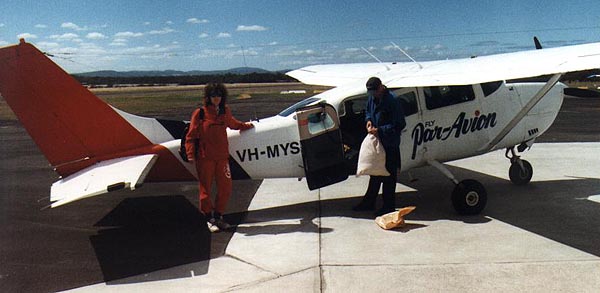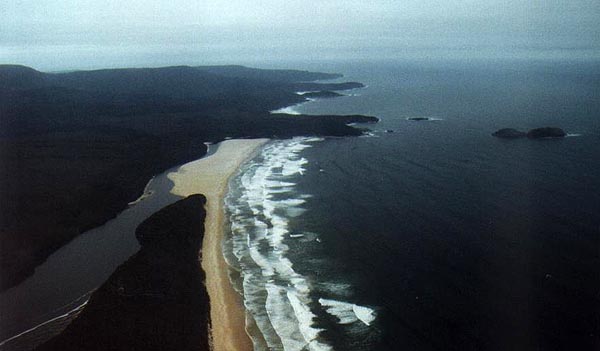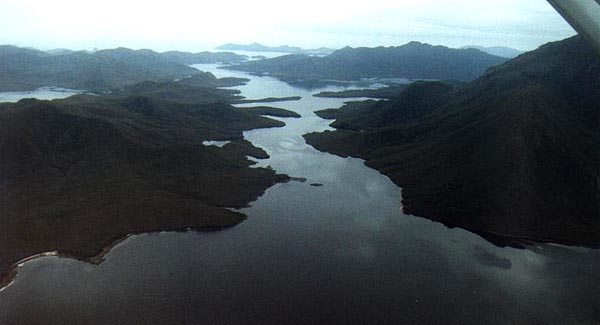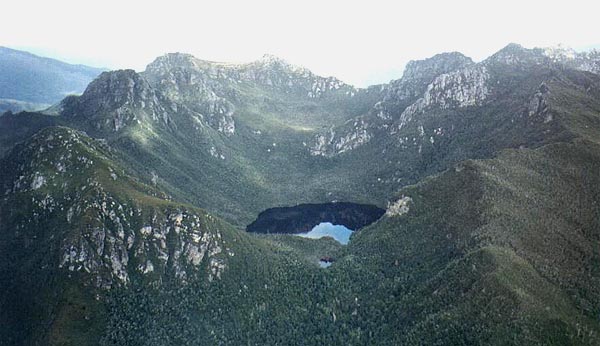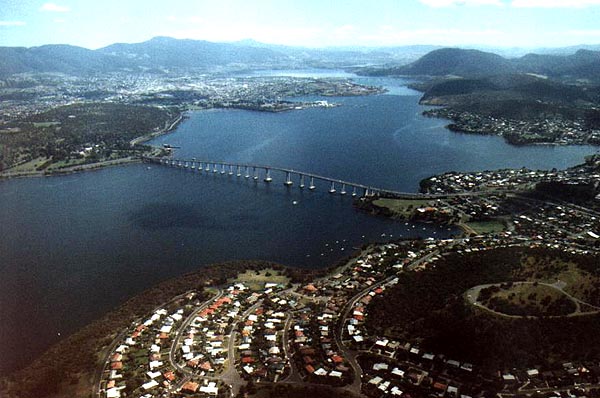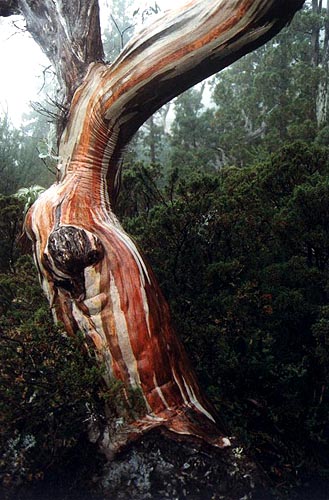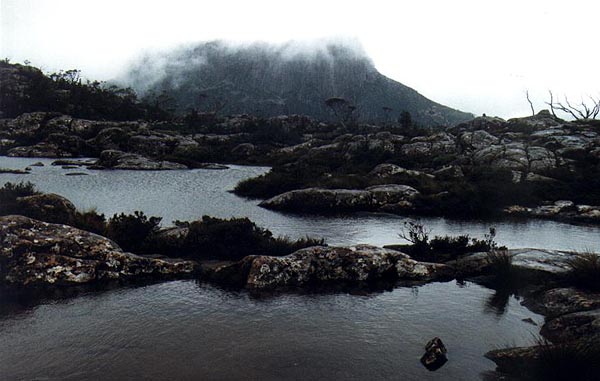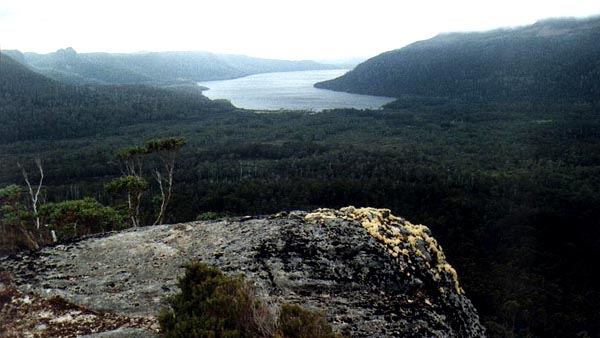Three Years on the Road
by
Brett Davis
69. Melaleuca and Lake St. Clair
|
Back in Hobart, while reading the tourist paraphernalia that accumulates in the corners of campers kitchens all over Australia, Karen and I happened across a brochure for a scenic flight to Melaleuca. No roads lead to this tiny speck on the map of south-west Tasmania. It can only be reached by air, sea or foot. Two famous walking tracks terminate at Melaleuca - the South Coast Track and the South-West Track. Both of these walks take about six days, and both walks are notoriously wet and boggy. Having just returned from the mires of the Loddon, Karen and I were neither physically nor mentally prepared for another walk in the mud, so a flight to Melaleuca was a much more attractive prospect.
Our six-seater plane took off from Hobart Airport and headed south-west over the Huon River towards South Cape. From there we followed the coast to Melaleuca, virtually following the entire route of the South Coast track. It was a lot easier in the air than it would have been on foot. Precipitous Bluff passed by on our right, while out to sea on our left was the Maatsuyker Island group, home of the last manned lighthouse in Australia.
The runway at Melaleuca was a narrow strip of white quartzite rubble. Our flight included a flat-bottomed boat cruise on the waters of Melaleuca Creek, a tributary of the drowned river valleys which form Port Davey and Bathurst Harbour. This area of water - four times larger than Sydney Harbour - had been created when sea levels rose at the end of the last ice age. After the cruise we also visited the house of Deny King, a naturalist who lived in the area for over forty years and who first noticed the decline in numbers of the Orange-Bellied Parrot.
A public information centre and bird observatory has been established at Melaleuca. Because we had arrived at midday, Karen and I felt we had very little chance of actually sighting the rare bird. Outside the windows of the observatory, in the middle of a large clearing, stood a forlorn and empty raised platform scattered with seed. Inside the windows of the observatory stood two forlorn bird watchers waiting hopefully with binoculars at the ready. Nothing happened for about ten minutes. Then I spotted a movement in a tree at the edge of the clearing.
The return flight to Hobart would have been anti-climactic had it not been for the attitude of the pilot. Rather than return directly, he decided a slight scenic deviation was in order. He headed towards the Western Arthurs. We flew along the entire range - a distance of only twenty kilometres which takes about six days to traverse on foot. When we reached the end the pilot turned around and flew down the other side of the range. Even the flattening effect of aerial observation could not hide the ruggedness of the mountains. We flew low enough to make out the footpads in the softer going beside many of the lakes. It was magic. One day, I thought, Karen and I would be walking down there. Beside me in the plane, Karen was thinking "No bloody way!"
Back along the Huon we flew, the scars of recent logging clearly visible in the forests below. The cloud covered top of Mount Wellington passed us by on the left as we began our descent into Hobart. I just had time to snap aerial shots of Constitution Dock and the Tasman Bridge before we landed. We had been in Tasmania for over five weeks now, and only one walk remained.
When Karen and I had walked the Overland Track in the eighties we had arrived at the head of Lake St. Clair and taken the water taxi back along the lake to the end of the walk. The walk notes had said that the long slog down to the ranger station at Cynthia Bay was not really worth the effort, while the alternate route around the back of Mount Olympus was longer and more difficult. Afterwards, Karen and I had regretted that we had not really completed the walk, and planned to return to Lake St. Clair one day to fill in the gap. The time had come.
Lake Petrarch was idyllic. Under cloudless skies we set up our tent on a white, sandy beach, with views of Mount Byron reflected in the shallow waters of the lake. A variety of eucalypt similar to the snow gum grew nearby, their red, orange and white bark glowing warmly in the late afternoon sunshine. Apart from a couple of hikers coming down the valley just after we had started, Karen and I had seen nobody all day. The lake was deserted, and we took advantage of our isolation to wash in the water just off our beach. It was cool, but not as cold as it might have been.
We eventually arrived at the Labyrinth proper, with lakes abounding and gnarled trees paying testimony to the harshness of the environment. The even light caused by the heavy overcast and the rain saturating the trees brought out the colours of the bark perfectly. I snapped shot after shot, when the mist cleared long enough. At one point the weather improved sufficiently for a photo across to the Acropolis, its summit ridge lost in whiteness. If we had been up there today looking towards the Labyrinth we would have seen nothing but the inside of a cloud.
The rain never let up as we returned to pack up our tent. In the afternoon we retraced our steps of the previous day back to Narcissus Hut. After a pleasant and very dry night, Karen and I embarked on another day trip, this time to the fourteen hundred and ninety one metre Mount Gould. Like our trip to the Labyrinth, the walk up Mount Gould was not a life-long wish, but just a pleasant walk to a scenic spot for excellent views down Lake St. Clair. It was also another peak bagged.
In the afternoon we returned to Narcissus Hut, picked up our gear and followed the Overland Track south along the western shore of Lake St. Clair to the Echo Point Hut, about halfway down the lake. We had avoided this section of the walk previously when we had taken the boat. Although it has a reputation as the most boring section of the Overland Track, Karen and I found the walk through the forests along the lake really fascinating. The trees were really impressive, perhaps because we had become accustomed to their stunted relatives at greater altitudes. Rather disturbingly, many of them had also fallen over or lost large limbs. It was with some relief that we finally exited the forest and made our way back to Cynthia Bay on the fifth day. |
